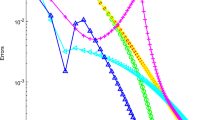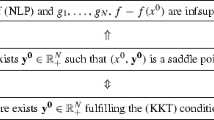Abstract
In this paper, we introduce the notion of generalized pseudolinearity for nondifferentiable and nonconvex but locally Lipschitz functions defined on a Banach space. We present some characterizations of generalized pseudolinear functions. The characterizations of the solution set of a nonconvex and nondifferentiable but generalized pseudolinear program are obtained. The results of this paper extend various results for pseudolinear functions, pseudoinvex functions and η-pseudolinear functions, and also for pseudoinvex programs, pseudolinear programs and η-pseudolinear programs.
Similar content being viewed by others
References
Ansari Q.H., Schaible S., Yao J.C.: η−pseudolinearity. Riviste Mat. Sci. Econom. Soc. 22, 31–39 (1999)
Chew K.L., Choo E.U.: Pseudolinearity and efficiency. Math. Prog. 28, 226–239 (1984)
Clarke F.H.: Optimization and Nonsmooth Analysis. SIAM, Philadelphia, Pennsylvania (1990)
Floudas, A.C., Pardalos, P.M. (eds): Encyclopedia of Optimization. Springer, Berlin (2009)
Jabarootian T., Zafarani J.: Generalized invariant monotonicity and invexity of non-differentiable functions. J. Global Optim. 36, 537–564 (2006)
Jeyakumar V., Mond B.: On generalised convex mathematical programming. J. Austral. Math. Soc. Ser. B 34, 43–53 (1992)
Jeyakumar V., Yang X.Q.: On characterizing the solution sets of pseudolinear programs. J. Optim. Theory Appl. 87, 747–755 (1995)
Komlósi S.: First and second order characterizations of pseudolinear functions. Eur. J. Oper. Res. 67, 278–286 (1993)
Kortanek K.O., Evans J.P.: Pseudoconcave programming and Lagrange regularity. Oper. Res. 15, 882–892 (1967)
Mangasarian O.L.: A simple characterization of solution sets of convex programs. Oper. Res. Lett. 7, 21–26 (1988)
Martos B.: Nonlinear Programming; Theory and Methods. Amsterdam, North-Holland (1975)
Mishra S.K., Wang S.Y., Lai K.K.: On non-smooth α-invex functions and vector variational-like inequality. Optim. Lett. 2(1), 91–98 (2008)
Pardalos, P.M., Rassias, T.M., Khan, A.A. (eds): Nonlinear Analysis and Variational Problems. Springer, New York (2010)
Rapcsák T.: On pseudolinear functions. J. Oper. Res. 50, 353–360 (1991)
Rapcsák T.: On the pseudolinearity of quadratic fractional functions. Optim. Lett. 1, 193–200 (2007)
Schaible S., Ibaraki T.: Fractional programming. Eur. J. Oper. Res. 12, 325–338 (1983)
Yang X.M.: On characterizing the solution sets of pseudoinvex extremum problems. J Optim. Theory Appl. 140, 537–542 (2009)
Author information
Authors and Affiliations
Corresponding author
Rights and permissions
About this article
Cite this article
Ansari, Q.H., Rezaei, M. Generalized pseudolinearity. Optim Lett 6, 241–251 (2012). https://doi.org/10.1007/s11590-010-0238-2
Received:
Accepted:
Published:
Issue Date:
DOI: https://doi.org/10.1007/s11590-010-0238-2




